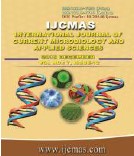


 National Academy of Agricultural Sciences (NAAS)
National Academy of Agricultural Sciences (NAAS)

|
PRINT ISSN : 2319-7692
Online ISSN : 2319-7706 Issues : 12 per year Publisher : Excellent Publishers Email : editorijcmas@gmail.com / submit@ijcmas.com Editor-in-chief: Dr.M.Prakash Index Copernicus ICV 2018: 95.39 NAAS RATING 2020: 5.38 |
Water is one of the most essential commodities for mankind and the largest available source of fresh water lays underground. Tremendous increase in the agricultural, industrial and domestic activities in recent years has increased the demand for good quality water to meet the growing needs. Groundwater is mostly preferred to meet this growing demand because of its lower level of contamination and wider distribution. The occurrence of groundwater is a consequence of the interaction of the climatic, geological, hydrological and physiographical factors. The surface hydrological features like topography, geomorphology, drainage, surface water bodies, etc. play important role in groundwater replenishment. Hence, identification and quantization of these features are important in generating groundwater potential model of a particular area. Remote sensing is an excellent tool for hydrologists and geologists in understanding the perplexing problems of groundwater exploration. In recent years, Satellite remote sensing data has been widely used in locating groundwater potential zones. Satellite remote sensing data is not only cost effective, reliable and timely but also meets the essential requirements of data in the geographical Information System (GIS) domain, which are “current, sufficiently accurate, comprehensive and available to a uniform standard”. Integration of the information on the controlling parameters is best achieved through GIS which is an effective tool for storage, management and retrieval of spatial and non-spatial data. Satellite data have been used to prepare various thematic maps, viz., geomorphological, geological, slope, drainage density, lineament density map. On the basis of relative contribution of each of these maps towards groundwater potential, the weight of each thematic map has been selected. Further, within each thematic map ranking has been made for each of the features. All the thematic maps have been registered with one another through ground control points and integrated step by step using the GIS for computing groundwater potential index. On the basis of this final weight and ranking, the ground water potential zones have been delineated. The groundwater potential zones are classified into five categories like very poor, poor, moderate, good and very good. This groundwater potential information is useful for effective identification of suitable locations for extraction of water. Thus, it is observed that an integrated approach involving remote sensing and GIS technique can be successfully used in identifying potential groundwater zones.
 |
 |
 |
 |
 |